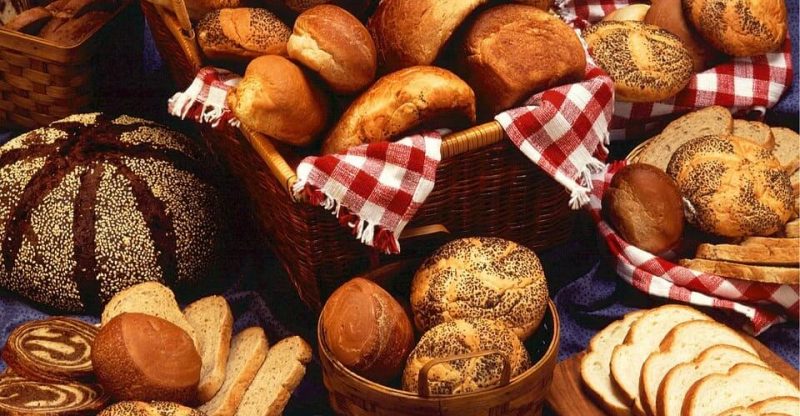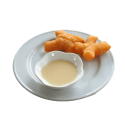What is Monocalcium Phosphate E341(i) in Food: Vegan, Uses, Safety, Side Effects

What is it | Production | Uses | Safety | Side Effects | FAQs
Monocalcium phosphate (MCP), or calcium dihydrogen phosphate, its food grade commonly used with sodium bicarbonate as a leavening agent in bakery foods. The European food additive number for it is E341(I). Generally, it is vegan, gluten free and dairy free.
What is Monocalcium Phosphate?
It is an inorganic compound derived from naturally occurring minerals and existing in two types:
- anhydrous with the chemical formula Ca(H2PO4)2
- monohydrate the commonly form and with the chemical formula Ca(H2PO4)2·H2O
What is it Made From?
Usually, it is produced by the reaction of calcium hydroxide or calcium carbonate with phosphoric acid. Food grade phosphoric acid is made from phosphate rocks by two main methods, a wet process or an electrothermal process. (1)
- In the wet process: phosphate rock is digested with a mineral acid, usually sulfuric acid, but nitric or hydrochloric acids may also be used.
- In the electrothermal process: the phosphate rock, coke and silica are heated in an electric resistance furnace to more than 1,100°C to extract elemental phosphorus from the ore. The elemental phosphorus is then oxidised to P4O10 (phosphorus pentoxide) and subsequently hydrated and the mist is collected.
Properties
Appearance
Granular powder or white, deliquescent crystals or granules.
Solubility
Sparingly soluble in water with the solubility 1.8%, 30°C. The PH value of its solution is around 3 due to the phosphoric acid produced by its hydrolysis in water. Insoluble in ethanol.
Other Names
- Monobasic calcium phosphate
- Monocalcium orthophosphate
- Phosphoric acid, calcium salt (2:1)
CAS Number
7758-23-8
Molecular Weight
- 234.05 (anhydrous)
- 252.08 (monohydrate)
What are the Uses of Monocalcium Phosphate?
MCP food grade is used as an acid component in baking powder; feed grade as a nutrition supplement of calcium and phosphorus in animal and poultry; and as a superphosphate fertilizer in agriculture.
Food
Monocalcium phosphate is a leavening acid commonly found in baked goods. Its purpose is to react with baking soda to provide aeration and volume by releasing carbon dioxide in the presence of water. The application such as in bread, biscuits, cookies, pancakes, self-rising flour, single and double-acting baking powder.
It is also often combined with slow-acting acids such as sodium acid pyrophosphate, sodium aluminum sulfate and sodium aluminum phosphate in double-acting baking powders.
Feed
Mono, di- and tricalcium phosphate are the three main types of inorganic feed phosphates. Mono and dicalcium phosphate (produced by calcined MCP at 270–350°C) are the most commonly used forms.
MCP feed grade benefits animal and poultry in both phosphorus (P) and calcium (Ca):
- Calcium: firms bone tissue and skeleton.
- Phosphorus: one of the most important minerals in animal nutrition. It plays an important role in the growth and cell differentiation (DNA), metabolism of energy and protein, controlling of appetite, the efficiency of feed utilization, fertility and etc.
Fertilizer
It supplies P and Ca nutrients to plants. It has the highest P content of dry fertilizers without nitrogen (N) which is suitable to plant that does not need additional N supplement.
Is Monocalcium Phosphate Safe to Eat?
Yes, its safety when used as a food additive has been approved by the U.S. Food and Drug Administration (FDA), European Food Safety Authority (EFSA), Joint FAO/WHO Expert Committee on Food Additives (JECFA), as well as other authorities.
FDA
It is generally recognized as safe (GRAS) when used in accordance with good manufacturing practice (2) AND can be used as a dough strengthener, firming agent, flour treating agent, leavening agent, malting or fermenting aid, nutrient supplement, ph control agent, sequestrant, stabilizer or thickener in food. (3)
The following is the application and usage advised by the FDA (4):
| Food Category | Uses Level |
| Bread, rolls, and buns. | <0.75% |
| Self-rising flour, self-rising white corn meal | The combined weight of monocalcium phosphate and sodium bicarbonate is not more than 4.5% |
| Phosphated flour | > 0.25% and < 0.75% |
Also, it is approved to add in fruit butters, jellies & preserves and canned vegetables.
EFSA
Monocalcium phosphate (E341i) is listed in Commission Regulation (EU) No 231/2012 as an authorised food additive and categorized as “additives other than colours and sweeteners” (5)
Safety Re-evaluation in 2019
In 2019, EFSA considered phosphates to be of low acute oral toxicity and there was no concern with respect to genotoxicity and carcinogenicity. Also, no effects were reported in developmental toxicity studies.
EFSA derived a group acceptable daily intake (ADI) for phosphates expressed as phosphorus of 40 mg/kg body weight (bw) per day and concluded that this ADI is protective for the human population.
Authorised Uses And Use Levels
Its application is listed together with other calcium phosphates by E 341. Its max uses level is 1000 (mg/l or mg/kg as appropriate) in almost all authorized food categories except in table-top sweeteners in powder form, which is QS.
The following foods may contain with it (6):
- Table-top sweeteners in powder form
- Cereals products
- Fruit-based desserts
- Dietary foods for infants for special medical purposes and special formulae for infants
UK Food Standards Agency
Categorized in “Others” (7)
Food Standards Australia New Zealand
It is an approved ingredient in Australia and New Zealand with the code number 341 as the name of calcium phosphate, monobasic or calcium dihydrogen phosphate. (8)
JECFA
Function Class: food additives, acidity regulator, firming agent, flour treatment agent, leavening agent, nutrient supplement, raising agent, sequestrant, texturizer, thickener and yeast food. (9)
Tolerable Intake: MTDI 70 mg/kg bw (as P) set in 1987. (10)
What are the Possible Side Effects?
It is common that sometimes consumers have questions whether monocalcium phosphate is bad for our health and what are the possible health risks. We understand that consumers prefer natural food additives and have concerns about the synthesized ingredients in the foods we eat. It is generally considered safe but some people may be allergic or sensitive to it.
Is it Safe for Pregnant?
Yes, it is generally safe but better consult with your doctor in the condition of use.
Frequently asked questions
Is it Natural?
No, it is derived from chemical synthesis.
Is it Vegan?
Yes, it is vegan as the raw materials calcium hydroxide or calcium carbonate usually come from limestone and other rocks instead of animal sources, such as oysters and mussel shells; also, phosphoric acid is from phosphate rocks. So it is vegan and suitable for the diet of vegetarians.
Is it Dairy Free?
Yes, it is dairy free as the calcium usually comes from limestone instead of animal sources. So people who’re lactose intolerance or with milk allergy can eat the food with it.
Is it Halal?
Yes, it is generally recognised as halal as it is permitted under the Islamic Law and fulfill the conditions of Halal. And we can find some manufacturers certificated with MUI halal.
Is it Kosher?
Yes, it is kosher pareve. E341(i) has met all the “kashruth” requirements and can be certified as kosher.
Is it Gluten Free?
Yes, it is typically gluten-free and people with celiacs can eat it. It is an ingredient commonly found in both gluten-free and gluten-containing food labels. The production complies with the FDA’s definition of gluten free, that it does not contain wheat, rye, barley, or crossbreeds of these grains.
What is it Made Of?
The anhydrous form is the pure Ca(H2PO4)2 while the monohydrate type is composed of one molecule Ca(H2PO4)2 and one molecule water.
How Much Calcium in it?
Anhydrous: Not less than 16.8% and not more than 18.3% of Ca
Monohydrate: Not less than 15.9% and not more than 17.7% of Ca
How Much Phosphorous in it?
P2O5 content between 55.5 % and 61.1 % on the anhydrous basis.
Is it A Preservative?
No.
Is it a Weak Acid?
Yes, calcium dihydrogen phosphate is a weak acid and makes up of baking powder with sodium bicarbonate. It is a quick-reacting leavening acid which releases carbon dioxide within minutes of mixing after the reaction with baking soda.
Conclusion
Now you may have a knowledge of Monocalcium phosphate (E341i), from the following aspects:
- Two types: anhydrous and monohydrate
- Manufacturing processes.
- Uses in food, feed, and fertilizer
- Safety
- Side effects
- FAQs: is it vegan, dairy free and so on.
What do you think of this additive? Let me know in the comments.



Dear Mr. James Hans,
I am from India and head an engineering company and work on phosphates- mostly large fertilizer projects but also on specific technologies. We hold a patent to produce DCP which is under commercial production since last 15 years in India. We are now helping a client to produce Mono Calcium Phosphate or Mono dicalcium phosphate-feed grade, and are looking to upgrade to food grade MCP. We can also produce slow acting leavening formula (with additive of calcium sulfate or aluminium sulfate etc)
We are keen to know your views if it would be possible to market the produce in Europe. Could you guide us in taking our product to market?
Thanks and Regards
Visweswara Rao
Hi Rao,
To have a better understanding of the market demand and customers, you can buy an import data (for Europe) of the products you plan to penetrate into the market.
Your information on monocalcium phosphate is very helpful. I have many food and medication sensitives and need to use natural food be they animal, vegetables or minerals. How can I get mono calcium phosphate, potassium bicarbonate and potato starch naturally, meaning without using chemical formulas?
I used a new to me organic self raising flour which contained monocalcium phosphate and had a severe reaction. Sharp chest pains lasting for 3 days, an indigestion which I have never had before. I have a very good diet free of additives and would be interested in your comments. I am sensitive to dairy but not wheat.
I found your article very informative and helpful. But, this food additive phosphorus is very dangerous for me and other people like me who have chronic kidney disease.
Another problem with this phosphorus is that the majority of foods on the back of the label do not give a percentage or a milligram count so, it makes it difficult to keep track how much you eat a day when food labels are not marked.
Is there a certain percentage that they are allowed to put in
the food that are not marked on the back of the label?
Thank you,
Loretta Davis
the usage of almost every ingredient is limited in food, but the percentage will not listed in the back of label, but you can know that the more the quantity of an ingredient is, the more front of its place in the ingredients list
I have been using mono calcium phosphate (calcium water 1 tsp per 1/2 cup water mixing well. The recommended use for most jams is 4 tsp of the mixture into your boiling water. The “calcium water” is what activates the pectin not the sugar in this case. Never have I had a problem with it. Haven’t used anything other than Pamona’s pectin for the last 20 years. Hard to find, but Amazon does have it. Good luck.
I used BakersCorner Cornbread Mix which contains some of these additives. Very quickly it became a
hyper allergen that caused swelling of complete tongue, throat and underneath chin. I could breathe but could not swallow causing extreme salivation. If you are highly sensitive, I would not recommend using this or any product containing this additive.